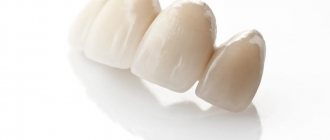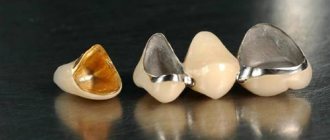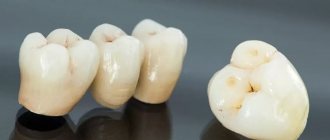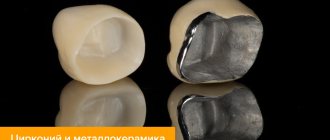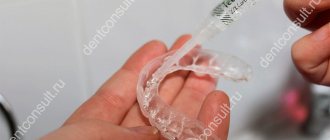HomeOrthopedic dentistryMetal ceramic crowns NORITAKE
The use of metal-ceramics in dental prosthetics is justified by the high strength of the material, expressive aesthetics and attractive price. That is why it is so popular among both doctors and patients. The metal-ceramic crown received its name due to the use of an internal metal frame and an external ceramic design, applied in layers. Final firing significantly increases the bond strength of these materials and the structure as a whole.
The main advantages of metal ceramics
The advantages of metal-ceramic crowns include:
- ultimate strength;
- high aesthetics;
- long service life - up to 10 years;
- affordable price.
What do you need to know about metal-ceramic prosthetics?
When choosing this method of prosthetics, patients should be aware that its benefits may vary significantly in different clinics. In addition, the quality of crowns depends on:
- preliminary preparation of teeth;
- grinding procedures;
- taking an impression.
Often, poor tooth filling led to the formation of an inflammatory process, followed by removal of the crown, long-term therapy and a new stage of prosthetics. To prevent this from happening, it is necessary to obtain a control image and consult a competent specialist who will confirm that the preparation was successful.
In our clinic, 99% of the time we prepare our patients’ teeth for crowns ourselves, since the methods we use provide 100% high-quality root canal treatment and do not lead to the formation of cysts and granulomas under the crowns. Since 2008, we have been using only 3D root canal filling using SLA SIEMENS dental laser.
The procedure for grinding teeth also has its own characteristics, namely the presence of a “ledge”. It is the presence of a ledge on the tooth that guarantees high-quality production of the crown and its many years of subsequent service. Thanks to this type of teeth grinding, food debris and bacteria do not accumulate under the crown, since it is a smooth continuation of the tooth root, as it should be by nature.
Making an impression requires no less attention. Its quality may be undesirably affected by the use of low-grade materials that are not able to accurately convey the characteristics of the oral cavity.
The slightest dishonesty at one of these stages threatens the formation of a loose fit to the neck of the tooth. As a result, saliva and food residues will penetrate into this gap, bacteria will develop, and the process of rotting will occur.
How to prepare for prosthetics
At the stage of preparation for prosthetics, it is necessary to take a targeted photograph of the tooth to assess the condition of the root - the presence of cracks, cysts or granulomas under the roots. If you have gum inflammation, you need to have them treated by a general dentist or periodontist. It is recommended to carry out sanitation of the oral cavity - cure caries, pulpitis, remove stone and plaque. And if there are old fillings on the neighboring teeth, then they need to be changed in order to correctly select the color of the future prosthesis. Then the root canals of the tooth are filled with high quality filling. After which you can proceed directly to prosthetics.
“I installed a Japanese crown “Noritak” about 5-6 years ago. What can I say, it still looks very good, it doesn’t wobble or try to fall out. But to get it installed, it took a long time to treat the tooth, because the pulpitis had previously been treated poorly in another clinic. Plus, the stump insert was made for a couple of weeks, and while I was walking around with a temporary prosthesis, I chewed very carefully. But the result was worth it."
Natalia N., review from the website stomatology.rf
Types of metal-ceramic crowns:
1. Classic metal-ceramic crowns - are created on the basis of a frame made of an inexpensive metal alloy: cobalt or nickel with chromium, which does not affect its strength. The top is decorated with ceramic mass. At the junction of the crown and the tooth in the cervical region of this crown, the metal comes into contact with the oral environment and saliva. Just this place will come into contact with the gum, undesirably affecting its color. To avoid this, you can choose the option with shoulder mass, and then the crown will have a layer of especially strong shoulder ceramic mass in the cervical area, which eliminates contact of the metal frame with the gum. However, the cost of such a crown is higher.
2. Crowns with a frame made of precious metal alloys. Such options have more advantages - the metal material from which they are made reacts more gently to the aggressive environment of the oral cavity and does not lead to additional problems. And most importantly, they allow you to obtain a significant resemblance between an artificial tooth and a real one. This happens because the ceramic mass is characterized by a slight translucency, and when it is applied to a base that contains gold, it acquires a slight yellowish tint.
3. Creating a crown on a milled metal frame assumes that the base will be made using a specialized machine. Performed using a digital program and special technology. This approach allows you to significantly increase the accuracy, and, consequently, the tightness of the crown to the dental neck, increasing the service life. The only drawback of this method is the high cost, which is of great importance for many patients.
The process of prosthetics with metal-ceramic crowns
The duration of this difficult process, from the turning procedure to the installation of crowns, is 10-14 days. It is simply unrealistic to complete such work in less time, since urgency can significantly affect the quality and shorten the service life. An important point in this process is the preliminary preparation of teeth for support.
What does therapeutic training include?
Of course, it all starts with an x-ray. If inflammatory phenomena are detected, a full treatment course is prescribed, followed by filling the canals. The same approach is used when the image shows a poorly performed filling, which is also subject to re-treatment.
When a patient has caries or poor-quality fillings on his teeth, anti-caries therapy and replacement of fillings must be carried out, taking into account the need for preliminary tooth depulpation. This manipulation involves removing the nerve, after which the root canals are filled. This is done if the patient has pulpitis or periodontitis. Living, intact teeth can be subjected to a similar procedure, but in some cases, for example, after the age of 50, metal-ceramic crowns can be installed on teeth while they are alive.
If the tooth is severely damaged - more than half of it - a pin is screwed into the root canal. The coronal part is restored onto such a base using filling material. Thanks to the pin, the restored fragment is strengthened, preventing it from collapsing during chewing.
If a tooth is completely destroyed almost to the root or has thin walls, the restorative procedure involves the use of a stump inlay, which is made of a metal alloy. In the future, a specialist will be able to use it to fix a metal-ceramic crown. This allows you to make the structure especially strong, preventing the destruction of the artificial crown. When the preliminary preparation is completed, the actual prosthetics begins, which includes several stages.
Indications and contraindications for prosthetics
Indications for installing a Noritake crown include the following situations:
- destruction of the top of the front or chewing tooth by half or more (when the filling can no longer be placed),
- destruction of the apex level with the gum: in this case, pins and a stump inlay are first installed into the root to strengthen and recreate the stump, and a metal-ceramic crown is fixed on top,
- increased abrasion of enamel,
- tooth extraction: several options are possible here, for example, you can install a metal-ceramic bridge, or you can choose a dental implant with a crown.
Contraindication is individual allergy to materials. Also, a crown cannot be placed if there are vertical cracks in the root - this requires removal and another type of prosthetics (implant, bridge or removable denture). And in case of pathological mobility of teeth (with periodontitis and periodontal disease), prosthetics1 with crowns can be dangerous, because the tooth will fall out along with the prosthesis - here a splinting clasp prosthesis is used as an alternative.
Stages of prosthetics
The tooth prepared for prosthetics is subjected to grinding, taking into account the thickness of the new crown. Then the specialist makes an impression of the dentition, which he sends to the dental laboratory. It is its employees, called dental technicians, who manufacture metal-ceramic crowns.
While metal-ceramic crowns are being made, the orthopedist usually suggests that patients install a temporary plastic option. This will help maintain aesthetic appeal, as well as provide fragile teeth after grinding with protection from the aggressive effects of the acidic environment of the oral cavity. There is a separate fee for this service. In the absence of available funds, specialized treatment of ground teeth with dentin-sealing liquid is possible.
When it comes to the entire process of dental prosthetics, you can consider several options that modern dentistry offers. From all the variety, you should choose the most suitable method based on price, quality, and number of missing teeth.
How to care for crowns
There is nothing complicated in caring for Noritake metal-ceramic crowns - they should be cleaned twice a day with a brush and paste. To preserve aesthetics for a long time, it is not recommended to consume brightly colored food and drinks, or to brush your teeth immediately after eating such food. To preserve the integrity of the prosthesis, it is better not to use your teeth for other purposes: do not open the lids with your teeth, do not chew nut shells. Periodically (about 1-2 times a year) you will have to visit the dentist for a professional examination and oral hygiene.
Installation of metal-ceramic crowns.
When installing metal-ceramics on the front row of teeth, it looks especially attractive when crowns are formed entirely on a group of upper or lower teeth. If only a few crowns are installed, they will have some difference in color tone and structure compared to your own teeth. Therefore, you should first read the reviews of patients who chose this prosthetic option and look at their photos with before and after options. This approach will help you make the right choice.
Cost of metal-ceramic prosthetics in 2022
When starting to monitor prices for prosthetic services in 2022, you need to be prepared for a wide range. In the price lists of numerous dental clinics there are offers for all kinds of metal-ceramic crowns, using a variety of materials, special technologies and installation methods.
The most popular options include:
Crowns made of cobalt-chromium alloy - they are created from fairly high-quality material made in Germany. Moreover, the cost for one crown is not less than 11 thousand rubles. When a more expensive ceramic mass is used, in Moscow dental clinics their cost range is 25-30 thousand rubles. In addition to the “shoulder mass”, which allows you to acquire a more attractive appearance of the gingival surface, the price will increase by another 2-4 thousand rubles. Of course, some dentists offer to install metal-ceramic crowns at a cost of 4.5 thousand rubles per piece. As a rule, such budget options use the cheapest Chinese materials and employ the labor of unqualified dental technicians. It is not surprising that after a little time the frame cracks and the ceramic coating peels off. In addition, the installation of such products is usually carried out by doctors and dental technicians, without sufficient experience and the necessary knowledge. The fact is that the work of excellent specialists requires appropriate payment.
The gold-platinum alloy in dental crowns affects not only their quality and aesthetic appearance, but also their cost. When calculated together with the cost of precious metal, the price for installing one crown will reach 45 thousand rubles.
Additional expenses. Like any major intervention, dental prosthetics may require additional costs. For example, if during the manufacture of metal-ceramic products the patient decides to temporarily install plastic crowns, then approximately 3-4 thousand rubles will be added to the total cost of the service. You will have to spend even more on therapeutic dental preparation, which can be quite expensive.
Cost of dental restoration
Prices for Noritake metal-ceramic crowns vary widely. In some clinics their cost starts from 10-12 thousand rubles, in others – from 20 thousand rubles. The low price is explained by the following - either the clinic provides treatment on a promotional basis, or the metal for the base cap is taken the most inexpensive (chromium alloy, for example), or the patient will still have to pay extra for preparing the tooth and installing the prosthesis.
1Danilina T.F., Shmakov A.M. Increasing the efficiency of prosthetics with fixed orthopedic structures, 2012.
QUESTION ANSWER
QUESTION Hello, I would like to know what is the best choice. They offer a choice of “Noritake” or “Duceram” crowns. Which is better to choose? Evgeniy REPLY Hello, Evgeniy.
In terms of their aesthetic and strength characteristics, metal-ceramic crowns Noritake and Duceram are approximately the same. Therefore, in your case, it is better to choose the brand that the dental technician is used to working with. Therefore, we recommend that you talk to your dentist about this topic. Practice shows that some technicians are better at using certain materials, while others are better at using others. But still, one difference between Noritake can be highlighted. If the metal base contains silver, the ceramic will not turn green. Although now they try not to use silver for crowns. Author: Sambuev B. S. (Thank you for your help in writing the article and the information provided)
Disadvantages of metal-ceramic crowns
Before undertaking any medical procedures, it is necessary to study possible contraindications. This also applies to metal-ceramic dental prosthetics. The fact is that some patients may experience allergic reactions to metals. Also, if there are other crowns made of metal alloys in the dentition, undesirable interaction between them may occur.
For example, it is possible that galvanism may occur in the form of micro-currents, leading to the formation of a metallic taste and diseases of the mucous membranes of the oral cavity.
In addition, some patients, after having teeth made from ordinary cheap metal-ceramics, remain dissatisfied:
- aesthetic appearance, namely the insufficient transparency of new crowns, with highly transparent enamel of their dentition, which makes noticeable differences in it. As you know, the presence of an internal metal base will not be able to give tooth enamel natural transparency and naturalness. To avoid this situation, you can use metal-free ceramics for your front teeth. Although for people with dense tooth enamel, metal-ceramic crowns would be an excellent option. They are also excellent for prosthetics of chewing teeth, even without the use of “shoulder mass”. a bluish tint to the gum surface or a dark line along the edge of the crown. Over time, such phenomena around false teeth can only get worse. The reason for the appearance of a bluish color on the gum lies in its contact with the metal edge of the crown. It looks especially unsightly when this type of prosthetics was used for the front tooth or when the gums were exposed during a smile. In addition, it is possible that a dark-colored line may form along the crown and gum. Gradually, the gums begin to recede, revealing the edge of the metal frame. Therefore, you should take special care of your attractiveness when choosing this prosthetic option.
What to do? To prevent cyanosis from appearing on the surface of the gums and a dark stripe from appearing, it is necessary to install a metal-ceramic crown with a “shoulder mass”. A feature of this manufacturing technology is the organization of complete isolation of the metal frame from contact with gingival tissue using ceramic masses. This will require additional labor-intensive costs, which, of course, will affect the cost of the service.
Other disadvantages of the procedure
Also, some patients in this type of prosthetics are confused by such manipulations as grinding a significant amount of dental tissue and depulping teeth.
Grinding of a significant amount of dental tissue, or rather turning for the installation of metal-ceramic crowns, is carried out on each side, reaching an average size of 1.5-2 mm. The exact depth depends on the wall thickness of the future crown. For example, when it is planned to place crowns made of metal-free ceramics or all-metal cast products, then grinding of the teeth requires less depth.
The need for depulpation of teeth arises precisely because of the significant depth of grinding of hard tissues, which increases the likelihood of thermal burns of the pulp and necrosis of the nerve. For this reason, dentists perform a pulp removal procedure. But it is taken into account that some teeth are characterized by a significant thickness of hard tissue, for example, on large molars. This allows you to keep them alive, increasing their life span.
Metal-ceramic or zirconium crowns – which one to choose?
When patients need dental prosthetics, they are faced with the question: which material to choose – zirconium or metal-ceramics? Especially when it comes to the front teeth. It is difficult to dispute the fact that products made from zirconium dioxide, with good manufacturing quality, have a more aesthetic appearance. However, they are ideal only for those people whose tooth enamel is not highly transparent.
This is explained by the non-transparency of the zirconium frame located inside such crowns. Like the metal base, it does not have the necessary coefficients of refraction and reflection of light like natural teeth. For this reason, crowns made of zirconium against the background of your own natural teeth will be characterized by low transparency and a defiantly unnatural “milky” tint. If your teeth are significantly transparent, it is recommended to abandon this option, since it is unlikely that anyone will be satisfied with such a dramatic result.
To make your teeth more attractive, you should choose lithium disilicate rather than zirconium dioxide to create it. This material is one of the varieties of ceramic masses. Based on it, ceramics such as IPS Emax are created. Two materials are excellent for creating dental crowns: Emax CAD and Emax PRESS. They can be safely used for dental prosthetics for a wide variety of patients. But most of all they are suitable for people with increased enamel transparency. Thanks to such unique properties of the material, both single crowns and bridges, including up to three units, are successfully formed from it.
This material is the best in modern dentistry, which is confirmed by European studies and reviews from satisfied patients.
At the Bionic Dentis clinic, orthopedic dentists have extensive experience in using lithium disilicate in dental prosthetics, since our clinic was one of the first in Russia to use this European technique.
What material is suitable for chewing teeth?
When creating crowns for chewing teeth, zirconium dioxide will serve as an adequate replacement for metal-ceramics. But such a structure can be weakened by chips of the ceramic covering the zirconium frame. Such damage can appear within 3-5 years and is observed in 10% of patients. It should be noted that the risk of chipping increases depending on the characteristics of the closure of the upper and lower dentition.
An excellent way to solve this problem is to create dental crowns from monolithic zirconium. They do not have a porcelain top layer, which is used for aesthetic appeal. Those patients who value reliability rather than beauty prefer this option.
And if you need a single crown with impeccable aesthetics, then it is better to take a closer look at the options created from IPS Emax ceramic mass using a highly practical pressing method. This material is also suitable for making crowns for chewing teeth.
How to replace metal ceramics?
If for some reason the patient is not suitable for the option of installing metal-ceramic crowns, then the question immediately arises: is it possible to replace this material with something? And as it turned out, yes, in modern dentistry there are many adequate replacements for metal-ceramics.
So:
For front teeth, metal-free ceramics are ideal because they have increased aesthetics, namely crowns made from lithium disilicate; For chewing teeth, experts advise giving preference to installing all-zirconium crowns made from a durable hypoallergenic composition - zirconium dioxide. It has been established that their reliability significantly exceeds metal-ceramic options. Moreover, the teeth undergo less grinding.
Such crowns are highly aesthetic, so they will not differ from natural teeth. Recent developments in the manufacture of zirconium dioxide crowns allow the use of several types of transparency (opaque, translucent and super translucent).
Such crowns will satisfy the aesthetic needs of any patient and are very durable.
The combined option assumes that some of the dental crowns will be hidden from prying eyes, while others will fall into the “smile zone”. The way out of this situation will be to form the dentition in such a way that the front teeth will be made of lithium disilicate, and the lateral teeth will be made of a more wear-resistant all-zirconium composition. However, in this case, you will need to accept that the lateral teeth will be slightly different in color from the front teeth. But this situation more than pays off in that the lateral teeth will be more durable and will last about 20 years.
The production of a combined version will cost the patient slightly less than a fully metal-ceramic bridge. Moreover, the teeth for its installation will be ground down much less, so their service life will increase.
Despite the large number of dental clinics and offices in Russia, the quality of services remains at a rather low level. Therefore, it is often negative reviews from patients. Although, if we directly consider the option of prosthetics with metal-ceramic crowns, then it has many advantages and cannot be called bad. The main reason lies in the lack of professionalism of clinic staff and their technical equipment.
What is the most common dissatisfaction among dental patients when receiving low-cost metal-ceramic prosthetics?
This list turns out to be quite voluminous:
Poor aesthetics – this is manifested by the fact that the crown stands out strongly against the background of natural teeth. When patients express their dissatisfaction with the doctor, he tries to convince them that everything should be exactly this way and not otherwise. Typically, this happens after the installation process has completed. In fact, it is necessary to make claims at the fitting stage, when the selection of a suitable option is just underway. Also, you should not rush to sign documents on the full provision of services, since unexpected shortcomings may appear at any time, the correction of which will require additional cash injections.
Mismatch between crown and tooth often occurs due to poor quality of the cast. In this case, the patient’s teeth may not close together or simply feel discomfort. In such cases, the doctor begins to file the finished crown in the mouth, which will only reduce its quality. But the worst thing is the loose fit of the crown to the gum, when saliva and food products penetrate into the gap and undergo the process of rotting there.
Pain and the formation of pus can occur as a result of poor-quality filling of root canals at the stage of therapeutic preparation of teeth for prosthetics. Such carelessness can lead to the appearance of a cyst in the upper part of the root with purulent inflammation. It is because of this that a person feels periodic pain when pressing the crown, swelling of the gums, and the occurrence of fistulas with suppuration. In case of such complications, it is necessary to remove the crown, carry out thorough treatment, and then a new staged prosthesis.
Crown fracture occurs due to inadequate therapeutic preparation of teeth for the prosthetic procedure. This happens when a natural tooth is half destroyed, for the restoration of which a pin and filling masses were used. Although it would be best to use a metal stump tab, which will serve as an excellent basis for the crown.
Chips of the ceramic veneer cause traumatic contact between the upper and lower dentition. Therefore, it is important that the dentist carefully checks the closure of the teeth, completely eliminating the development of such a situation. If necessary, selective sanding is carried out; when this is not done, chips appear. In addition, such destruction occurs when low-quality ceramic masses are used or the manufacturing technology of the structure is violated. Eating nuts and seeds can have a negative impact. This phenomenon is considered quite common, and to eliminate it, correction is carried out using ceramic mass directly in the oral cavity.
Thus, the low cost of services can result in significant subsequent costs for the patient when additional treatment and recovery are required. The choice of a clinic and specialist must be approached with all responsibility, paying attention to existing merits, reputation and customer reviews. There is no need to rush into signing documents, especially if something raises doubts or dissatisfaction. It is important to feel how suitable a particular type of prosthetics is, providing the desired comfort, aesthetics and functionality.
You should receive all receipts and checks for payment for treatment and take care of their safety. It would be a good idea to keep copies of dental photographs and medical records. If you are not satisfied with something, you need to boldly contact the head of the clinic and demand that the unsatisfactory work be redone.
How long will metal-ceramic crowns last?
Most dental clinics in Moscow provide mandatory guarantees for prosthetic services for a period of one year. At the same time, metal-ceramic crowns can last on average 5-15 years. However, such a long period can be counted on, provided that all stages of prosthetics were carried out efficiently. According to statistics, serious problems in Russian patients arise after 1-2 years. Their cause often lies in poor-quality root canal filling during therapeutic preparation. As a result, repeated treatment and new prosthetics are carried out at our own expense.
To prevent such a course of events, it is recommended: before the end of the warranty period, undergo a control x-ray examination of prosthetic teeth. This must be done even if they do not cause any concern, since pain from inflammatory processes may not be felt immediately. If the x-ray reveals undesirable changes, then treatment and new prosthetics will be carried out at the clinic’s expense within the limits of the warranty. Therefore, it is important to have time to fix everything before the warranty expires!
Unfortunately, unscrupulous doctors, in order not to eliminate the results of their poor quality work, conceal the real state of affairs. In this case, you can undergo an x-ray examination in another clinic and get a consultation with another doctor there.
These are the problems that patients usually face when they want to save on dental treatment and prosthetics. In order for the procedures to be successful and a positive result to be achieved, it is necessary to contact trusted specialists who work in the best clinics in Moscow. Only with this approach can you be sure that you will truly receive services with a guarantee of quality!
Advantages of installing metal-ceramic crowns at the Bionic Dentis clinic:
1. We use only biocompatible metal alloy for crown frames, which we produce using CAD CAM robotic milling. Such frames have no internal tension and ideally correspond to the shape of the ground tooth.
2. Premium ceramic masses Noritake (Japan) are used for lining crowns. These are the best ceramics in the whole world. Possessing high strength characteristics, such ceramic masses practically do not chip off the frame. The high aesthetics of crowns made from Noritake mass distinguishes them from all others for the better.
3. To take an impression of the dentition, we use only highly accurate impression mass made of class A silicone. It accurately conveys the relief of the tooth prepared for the crown and is not deformed.
4. We produce only metal-ceramic crowns with shoulder mass, which avoids darkening of the gums in the area of the neck of the tooth.
5. To fix the crown, we use special compounds - light-curing cements. These dental cements are a new direction in fixing crowns. Due to the light-curing and high strength of such cement, microorganisms cannot penetrate under the crown, which increases service life by 200%.
Dental prosthetics with metal-ceramic crowns is a classic of dental care for the population all over the world. However, there are innovations in this seemingly ubiquitous technique.
Ozerov Petr Vladimirovich
Chief physician. Dentist, implantologist, orthopedist, surgeon. Laser dentistry specialist
More details
Frolov Andrey Konstantinovich
Orthopedic dentist
More details
Andreev Dmitry Lvovich
Dentist orthopedist-implantologist.
More details
Working with manufacturers of ceramic mass to produce crowns directly, we use the latest trends in world practice for this type of prosthetics. Our dental technicians are high-level specialists and have been producing reliable, durable and beautiful metal-ceramic crowns for our patients for 15 years. By contacting our clinic, you will receive a high level of dental care and will be satisfied with our work for decades of wearing crowns.
Advantages and disadvantages
Considering the pros and cons of Noritake metal-ceramic crowns, it should be noted that the number of advantages outweighs the number of disadvantages. We suggest you look at the positive aspects in more detail:
- high aesthetics: restorations look like “natural” teeth,
- strength,
- resistance to cracking of ceramics at high temperatures,
- resistance to abrasion during operation,
- maintainability,
- quick adaptation and easy care,
- long service life with high-quality manufacturing and careful wearing.
There are practically no disadvantages to Noritake cladding ceramics. However, some dentists note that it is more susceptible to chipping than, for example, IPS d.SING from Ivoclar Vivadent or Ceramco3 from Dentsply Sirona. But the appearance of chips may well be explained by a violation of manufacturing or operating technology.
Don't know what type of prosthetics to choose?
We will help in the selection, advise where to read more information and compare types of prosthetics.
Consultation with an orthopedic doctor in Moscow clinics is free! Call now or request a call
Working hours: from 9:00 to 21:00 - seven days a week


